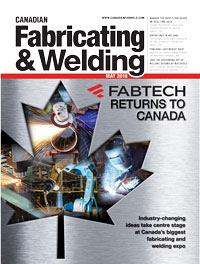Editor
- FMA
- The Fabricator
- FABTECH
- Canadian Metalworking
Roll forming high-strength steels
Creative approaches necessary to work hard-to-form materials
- By Rob Colman
- May 28, 2018
- Article
- Fabricating

Samco Machinery produced this sampling of rocker and bumper profiles on roll forming equipment designed for the automotive industry. All of these profiles would have gone through FEA prior to machine production.
High-strength steels have become increasingly popular for use in the automotive industry mainly because of their very high strength-to-weight ratios. However, formability in these same materials remains a problem; the yield strength is very high in these metals, which means the springback is very high. This makes roll forming parts a challenge. However, the efficiency of roll forming makes it an ideal process for producing certain parts compared to hot stamping. If you intend to roll form high-strength steels, it’s important to understand how you have to adjust your equipment to get the best results. You also have to consider the steel you are purchasing and how that is affecting the process.
Pushing the Bend Basics
“With mild steel, if you bend a part, say, 45 degrees, it will stay at 45 degrees or spring back perhaps 1 or 2 degrees,” said Sabri Tarzian, roll tooling manager at Samco Machinery. “In very high-strength steel, you have very high springback, which means to get a 45-degree bend, you have to overbend it to 50 or 60 degrees.”
Tarzian noted that end flare – the distortion that occurs at the end of roll formed parts – can be quite pronounced on high-strength steel roll formed parts for this same reason.
“The leading and tailing ends of parts will react differently than the middle of the material,” he explained. “It is usually more pronounced with high-strength steels, so it is necessary to ‘kill’ the memory of the material by overbending and underbending it.”
“The strength of the material means you need more power, you need more tonnage, and usually the material and tooling costs are generally higher because of the added passes involved,” said David Rostocil, senior technical performance specialist at Roll-Kraft.
“Machine-wise, we like to put larger-diameter spacers in backup rolls to keep the column strength steady throughout the shafts with the higher-strength steel,” said Rostocil. “In the roll tooling itself, we like to use the shortest possible roll space to minimize spindle deflection. Depending on the size of your spindle, you can get a lot of deflection. If you have a 24-in. roll space and you are running a 10-in.-wide coil through the machine, you may want to choke up the outboard stands to minimize the roll space width so that you avoid spindle flex.”
If the horizontal distance between passes is large, Rostocil recommends the use of side rolls to add extra support.
“As the part exits one pass, it opens up and then has to go back into the next roll,” said Rostocil. “If the customer has enough side roll stands, the part keeps a better uniform shape by using them. This also minimizes some of the end flare you inevitably see on parts, although it doesn’t remove it completely.”
Rostocil also noted that when high-strength material is run and because of the amount of forming being done, the tooling will wear faster in the working areas. Roll-Kraft recommends adding carbide rolls to the high-wear areas doing the forming to increase the tooling life.
“Rolls can wear twice as fast when they are used for high-strength steels,” he explained. “With carbide added, they can last up to 50 times longer than conventional, hardened tool steel rolls.
Last, Rostocil discourages the use of tight hems in designs for high-strength steels. “Hems should be avoided if the material will not allow the amount of elasticity or elongation needed to form the hems,” he said.
Steel Source Struggles
The challenge with high-strength steels, especially martensitic, as Tarzian explained, is that the range of the yield is too high from coil to coil, and you get flatness and camber issues.
“One coil may be 120 kilopounds per square inch [KSI], and the next could be 160 KSI,” he said. “The two will react differently during forming, and that will require adjustment in the tooling. This means that in your roll tooling design, you need to have some adjustment or specific passes to deal with it. This requires training your operator to run this extra step.”
Rostocil had a customer that used a stretch leveller for material to pull the grain to help minimize the variability from coil to coil for better control of the roll form process. “Stretcher levelling beats roller levelling, tension levelling, and even temper pass as the way to achieve 'stay-flat' steel,” said Rostocil. “Stretcher levellers transform material with significant stress and edge wave into perfectly flat, stress-free material.”
“[Our customer is] getting really good control using that,” he said. “Before that every coil was different and it was completely inconsistent.”
But some of Rostocil’s other customers are still struggling with consistency.
“We have a customer now that is doing a side frame panel for a vehicle that uses 14 passes for a U-panel and they can’t run it consistently,” he explained. “To remedy that we’re putting in large, almost football-like rolls crowning up and crowning down to try to get the material more consistent going into the passes.”
Some fabricators are seeing variation within the same coil.

Colours are the design software’s method of showing the designer the various conditions in the part as related to stress and strain.
“We had a customer for whom we fabricated a set of tooling for a part. We tested it, installed it, but when they started production, they could not get it to work,” said Tarzian. “We checked their coil and saw that, in a 12-foot piece, you could see concavity, convexity, twists, everything. The company had another type of coil from another supplier that was tension-levelled and we were able to run that on the machine. But with the coil available, there was nothing we could do. We basically had to say, ‘We cannot adjust for this, unless you open the tolerances and live with what the roll former delivers.’ That is the effect of a bad coil, and it’s a challenge with there being so few suppliers for some of these high-strength steels. And the tolerances in a lot of these automotive applications are too tight to allow for the variation created by bad coil.”
Software Advances
Roll forming is often perceived as an art because so much technical detail goes into making a formed part correctly. However, as Tarzian explained, software advancements have affected roll forming in much the same way that it has altered other fabricating disciplines.
“We use COPRA® finite element analysis (FEA) in the development of the roll tooling,” he said. “After we design the rolls, we put the design through COPRA FEA and we can see how the material behaves from one pass to another, one station to another, and we can make adjustments according to what we are seeing. On the computer we’re simply changing lines and arcs. This way we don’t need to deal with delays on the floor. Most issues can be resolved during the design stage. The software is particularly useful when addressing automotive applications that demand such tight tolerances.”
The use of high-strength steels is important for safety and fuel efficiency in vehicles. As a material, it’s more consistent once formed than softer gauge material, and while it has flatness and camber issues, you have less galling on the material, and you get less hole distortion on a pre-punch. While high-strength steel can be challenging to work with, manufacturers’ demand for it makes it worth understanding better.
Editor Robert Colman can be reached at rcolman@canadianfabweld.com.
Roll-Kraft, www.roll-kraft.com
Samco Machinery, www.samco-machinery.com
About the Author

Rob Colman
1154 Warden Avenue
Toronto, M1R 0A1 Canada
905-235-0471
Robert Colman has worked as a writer and editor for more than 25 years, covering the needs of a variety of trades. He has been dedicated to the metalworking industry for the past 13 years, serving as editor for Metalworking Production & Purchasing (MP&P) and, since January 2016, the editor of Canadian Fabricating & Welding. He graduated with a B.A. degree from McGill University and a Master’s degree from UBC.
subscribe now


Keep up to date with the latest news, events, and technology for all things metal from our pair of monthly magazines written specifically for Canadian manufacturers!
Start Your Free Subscription- Industry Events
MME Saskatoon
- May 28, 2024
- Saskatoon, SK Canada
CME's Health & Safety Symposium for Manufacturers
- May 29, 2024
- Mississauga, ON Canada
DiPaolo Machine Tools Open House 2024
- June 4 - 5, 2024
- Mississauga, ON Canada
FABTECH Canada
- June 11 - 13, 2024
- Toronto, ON Canada
Zoller Open House & Technology Days 2024
- June 12 - 13, 2024
- Ann Arbor, MI






















